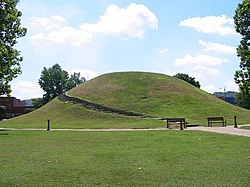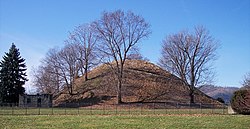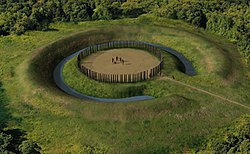 Geographic distribution of the Adena (500 BC–100 AD), Hopewell (200 BC–500 AD), and Fort Ancient (1000–1750 AD) cultures.[ citation needed ] | |
| Geographical range | Midwestern United States |
|---|---|
| Period | Early Woodland period |
| Dates | c. 500 BC to c. 100 AD |
| Type site | Adena mound |
| Major sites | Criel Mound, Grave Creek Mound, and Miamisburg Mound |
| Preceded by | Archaic period |
| Followed by | Ohio Hopewell |
 |
| Mound Builders |
|---|
| Culture |
| Polities |
| Archaeology |
| Religion |
The Adena culture was a pre-Columbian Native American culture that existed from 500 BC [1] to 100 AD, [2] in a time known as the Early Woodland period. [3] The Adena culture refers to what were probably a number of related Native American societies sharing a burial complex and ceremonial system. The Adena culture was centered on the location of the modern state of Ohio, but also extended into contiguous areas of Kentucky, West Virginia, Indiana, Illinois, Southern Wisconsin and parts of extreme western Pennsylvania. [3]








